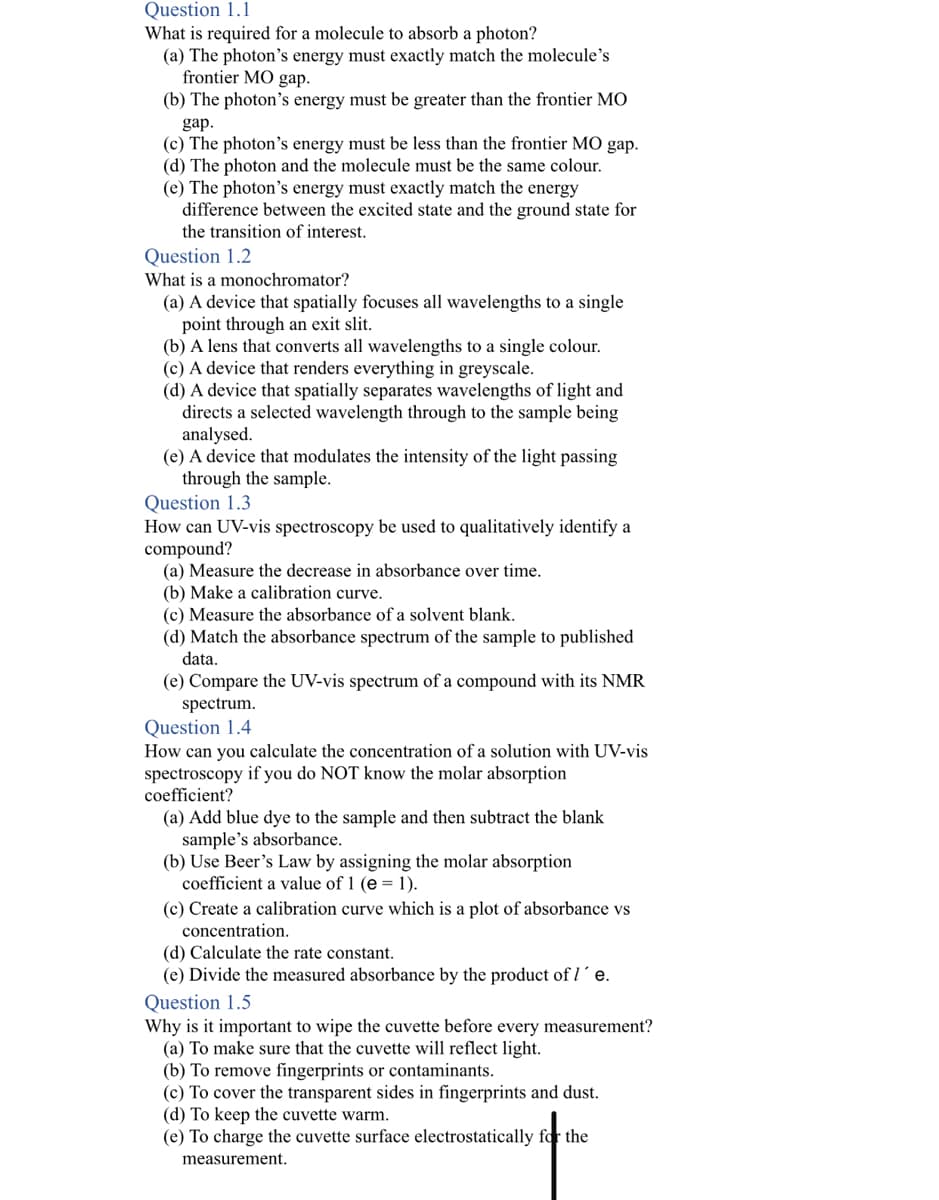Question 1.1 What is required for a molecule to absorb a photon? (a) The photon's energy must exactly match the molecule's frontier MO gap. (b) The photon's energy must be greater than the frontier MO gap. (c) The photon's energy must be less than the frontier MO gap. (d) The photon and the molecule must be the same colour. (e) The photon's energy must exactly match the energy difference between the excited state and the ground state for the transition of interest.
Question 1.1 What is required for a molecule to absorb a photon? (a) The photon's energy must exactly match the molecule's frontier MO gap. (b) The photon's energy must be greater than the frontier MO gap. (c) The photon's energy must be less than the frontier MO gap. (d) The photon and the molecule must be the same colour. (e) The photon's energy must exactly match the energy difference between the excited state and the ground state for the transition of interest.
Related questions
Question

Transcribed Image Text:Question 1.1
What is required for a molecule to absorb a photon?
(a) The photon's energy must exactly match the molecule's
frontier MO gap.
(b) The photon's energy must be greater than the frontier MO
gap.
(c) The photon's energy must be less than the frontier MO gap.
(d) The photon and the molecule must be the same colour.
(e) The photon's energy must exactly match the energy
difference between the excited state and the ground state for
the transition of interest.
Question 1.2
What is a monochromator?
(a) A device that spatially focuses all wavelengths to a single
point through an exit slit.
(b) A lens that converts all wavelengths to a single colour.
(c) A device that renders everything in greyscale.
(d) A device that spatially separates wavelengths of light and
directs a selected wavelength through to the sample being
analysed.
(e) A device that modulates the intensity of the light passing
through the sample.
Question 1.3
How can UV-vis spectroscopy be used to qualitatively identify a
compound?
(a) Measure the decrease in absorbance over time.
(b) Make a calibration curve.
(c) Measure the absorbance of a solvent blank.
(d) Match the absorbance spectrum of the sample to published
data.
(e) Compare the UV-vis spectrum of a compound with its NMR
spectrum.
Question 1.4
How can you calculate the concentration of a solution with UV-vis
spectroscopy if you do NOT know the molar absorption
coefficient?
(a) Add blue dye to the sample and then subtract the blank
sample's absorbance.
(b) Use Beer's Law by assigning the molar absorption
coefficient a value of 1 (e = 1).
(c) Create a calibration curve which is a plot of absorbance vs
concentration.
(d) Calculate the rate constant.
(e) Divide the measured absorbance by the product of I´e.
Question 1.5
Why is it important to wipe the cuvette before every measurement?
(a) To make sure that the cuvette will reflect light.
(b) To remove fingerprints or contaminants.
(c) To cover the transparent sides in fingerprints and dust.
(d) To keep the cuvette warm.
(e) To charge the cuvette surface electrostatically for the
measurement.
Expert Solution
This question has been solved!
Explore an expertly crafted, step-by-step solution for a thorough understanding of key concepts.
This is a popular solution!
Trending now
This is a popular solution!
Step by step
Solved in 2 steps
